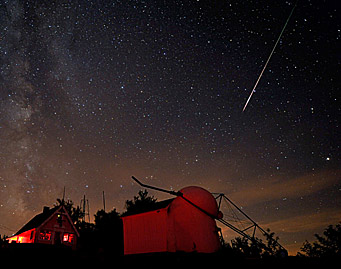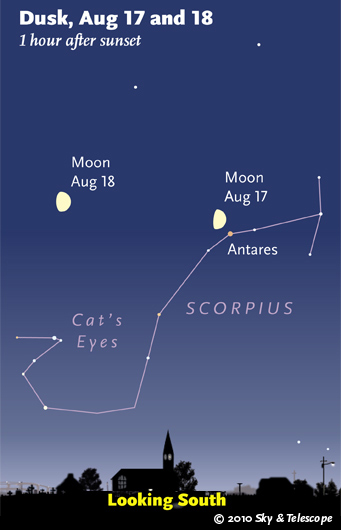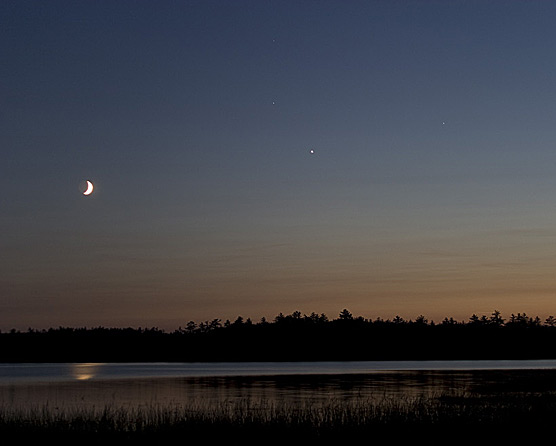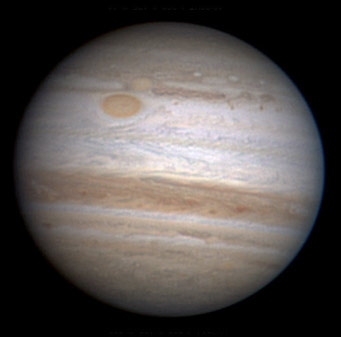Friday, August 13

A bright early Perseid meteor streaked down over the Stellafane convention in Springfield, Vermont, on August 7th. Click for larger view.
Credit: Sky & Telescope / Dennis Di Cicco
Track the shower's continuing progress with the International Meteor Organization's near real-time activity profile, which is based on reports being sent in by the IMO's visual observers worldwide. And here are several pages of Perseid photos at Spaceweather.com.
Saturday, August 14
Sunday, August 15
Monday, August 16

The waxing Moon crosses Scorpius on Tuesday and Wednesday. (These scenes are drawn for the middle of North America. European observers: move each Moon symbol a quarter of the way toward the one for the previous date. For clarity, the Moon is shown three times actual size.)
Sky & Telescope diagram
Tuesday, August 17
Wednesday, August 18
Thursday, August 19
Friday, August 20
The asteroid-occultation community eagerly seeks accurate timings of such events, especially by video, which is more precise than eyeball timings. Read up on timing methods. If you get involved in this addictive pursuit, join the busy discussion at the occultation Yahoo Group.
Saturday, August 21
Want to become a better amateur astronomer? Learn your way around the constellations. They're the key to locating everything fainter and deeper to hunt with binoculars or a telescope.
For an easy-to-use constellation guide covering the whole evening sky, use the big monthly map in the center of each issue of Sky & Telescope, the essential magazine of astronomy. Or download our free Getting Started in Astronomy booklet (which only has bimonthly maps).

The Pocket Sky Atlas plots 30,796 stars to magnitude 7.6 — which may sound like a lot, but that's less than one star in an entire telescopic field of view, on average. By comparison, Sky Atlas 2000.0 plots 81,312 stars to magnitude 8.5, typically one or two stars per telescopic field. Both atlases include many hundreds of deep-sky targets — galaxies, star clusters, and nebulae — to hunt among the stars.
Sky & Telescope
Once you get a telescope, to put it to good use you must have a detailed, large-scale sky atlas (set of charts). The standards are the Pocket Sky Atlas, which shows stars to magnitude 7.6; the larger Sky Atlas 2000.0 (stars to magnitude 8.5); and the even larger and deeper Uranometria 2000.0 (stars to magnitude 9.75). And read how to use your charts effectively.
You'll also want a good deep-sky guidebook, such as Sky Atlas 2000.0 Companion by Strong and Sinnott, or the more detailed and descriptive Night Sky Observer's Guide by Kepple and Sanner, or the classic if dated Burnham's Celestial Handbook.
Can a computerized telescope take their place? I don't think so — not for beginners, anyway, and especially not on mounts that are less than top-quality mechanically. As Terence Dickinson and Alan Dyer say in their Backyard Astronomer's Guide, "A full appreciation of the universe cannot come without developing the skills to find things in the sky and understanding how the sky works. This knowledge comes only by spending time under the stars with star maps in hand."
This Week's Planet Roundup

"Conjunction over Massebesic Lake": Moon, Mars, Venus, and Saturn on Aug 13, 2010. "Fed the mosquitos quite well on the beach tonight," writes S&T's Sean Walker from New Hampshire.
S&T: Sean Walker
Mercury is now lost in the glow of sunset.
Venus (magnitude –4.4) is the bright Evening Star sinking low in the west during twilight.
Mars and Saturn (magnitudes 1.5 and 1.1, respectively) are near brilliant Venus low in twilight. Mars slowly skims a few degrees above Venus this week, while Saturn moves increasingly far off to Venus's right or lower right. Look carefully; Mars and Saturn are less than 1% as bright as the dazzler.
Left of this group, look for Spica. Very high above them shines brighter Arcturus.

By August 13th, Jupiter's Oval BA (Red Spot Junior) had nearly caught up with the Great Red Spot and was about to pass it. Also note the ghostly tan and blue-gray signs of the broad South Equatorial Belt hidden under white clouds. These traces now include the outline of the Red Spot Hollow just below the spot. South is up.
Christopher Go took this stacked-video image at 18:03 UT Aug. 13, 2010.
Alan MacRobert
Jupiter (magnitude –2.7, in Pisces) rises around the end of twilight and is well up in the east-southeast by midnight. It's highest in the south before dawn — the brightest starlike point in the morning sky.
Jupiter's Great Red Spot is near System II longitude 150°. Assuming it stays there, here's a list to print out of all the Great Red Spot's predicted transit times for the rest of 2010.
Uranus (magnitude 5.8, in Pisces) is less than 3° west of Jupiter. In a telescope Uranus is only 3.6 arcseconds wide, compared to Jupiter's unusually wide 48″.
Neptune (magnitude 7.8, at the Aquarius-Capricornus border) is up high by late evening. See our finder charts for Uranus and Neptune in 2010.
Pluto (magnitude 14, in northwestern Sagittarius) is highest in the south right after dark, but the Moon reenters the evening sky this week. See our big Pluto finder charts in the July Sky & Telescope, page 60.
All descriptions that relate to your horizon or zenith — including the words up, down, right, and left — are written for the world's mid-northern latitudes. Descriptions that also depend on longitude (mainly Moon positions) are for North America. Eastern Daylight Time (EDT) equals Universal Time (also known as UT, UTC, or GMT) minus 4 hours.
To be sure to get the current Sky at a Glance, bookmark this URL:
http://SkyandTelescope.com/observing/ataglance?1=1
If pictures fail to load, refresh the page. If they still fail to load, change the 1 at the end of the URL to any other character and try again.
 0
0
Comments
You must be logged in to post a comment.